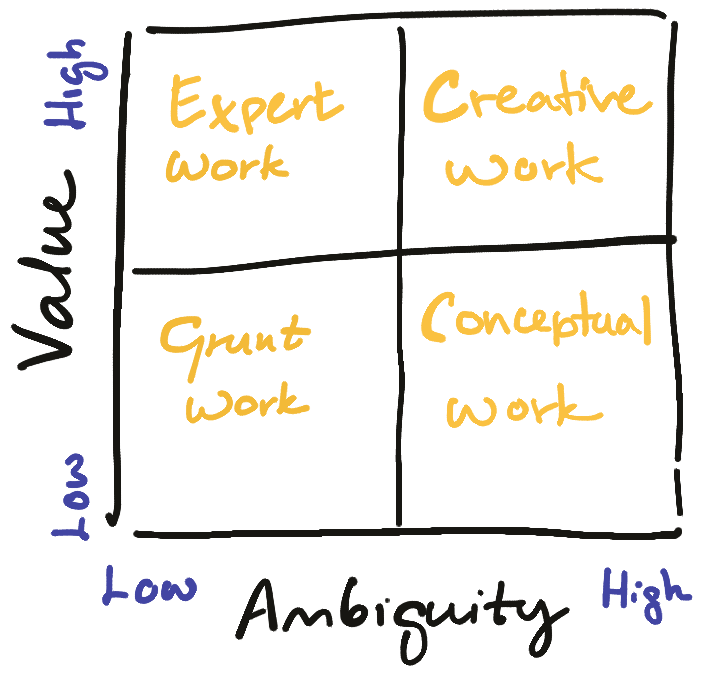Not long ago I was leading a team of people on a months-long project with many work-streams and many more tasks. The tasks varied greatly in ways I have not thought about before and sparked the thoughts that went into this article.
Software engineers do their best work when the majority of the tasks are in line with the amount of ambiguity they accept and when the value of their work is in line with their expectations.
Value – the meaningfulness and impact of work – is a perception shaped by various factors. It is essential to differentiate between the value that work holds for the person and the potential value it may have for the business.
Ambiguity – the challenges and uncertainties a person may face at work – is a subjective experience, varying among individuals. Those with more experience and confidence navigate ambiguity easier, while others may attempt to avoid it.
Dissecting these two aspects of work along low to high ranges into four quadrants, each quadrant characterizes a type of work.

Grunt work is routine tasks requiring minimal decision-making or specialized expertise.
Think of data entry, manual data validation, or repetitive administrative duties. Grunt work is essential for maintaining operational efficiency, but it can also be monotonous and disengaging for knowledge workers.
As engineer leads, it is crucial to minimize the impact of grunt work by automating processes and providing opportunities for skill development and growth.
Expert work requires deep domain knowledge, specialized skills, and a mastery of specific tools or technologies. Experts enjoy problem-solving and executing tasks with precision and efficiency.
As engineer leads, it is important to recognize and cultivate expertise within teams.
Conceptual work involves exploring abstract ideas, brainstorming possibilities, and conceptualizing new approaches. While the value may not be immediately apparent, conceptual work lays the foundation for future breakthroughs.
Engineer leads must create an environment that encourages experimentation, risk-taking, and out-of-the-box thinking.
Creative work involves pushing boundaries, challenging conventional thinking, and envisioning new possibilities. Creativity fuels innovation, enabling knowledge workers to think beyond existing frameworks and reimagine solutions.
Engineer leads must foster a culture that embraces creativity, encouraging diverse perspectives, and providing the freedom to explore uncharted territories.
Recognizing that individuals thrive in different quadrants of the ambiguity-value matrix is crucial in fostering a productive team. By understanding the specific type of tasks required for a project, engineer leads can compose efficient teams. It also enables individuals to perform at their best and maximize their contributions. Moreover, allowing team members to experiment and explore various quadrants of their choice promotes personal growth, stimulates innovation, and cultivates a sense of ownership and empowerment.